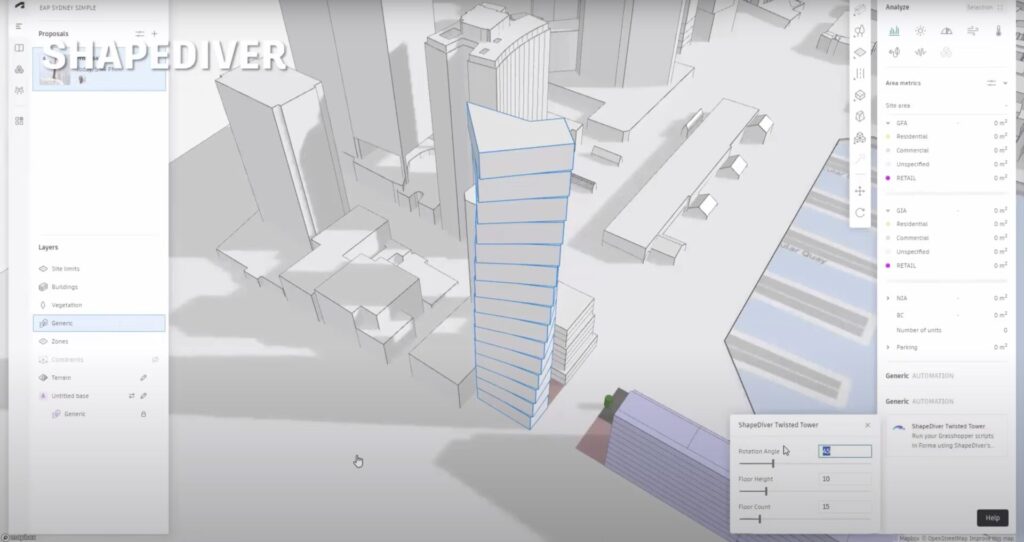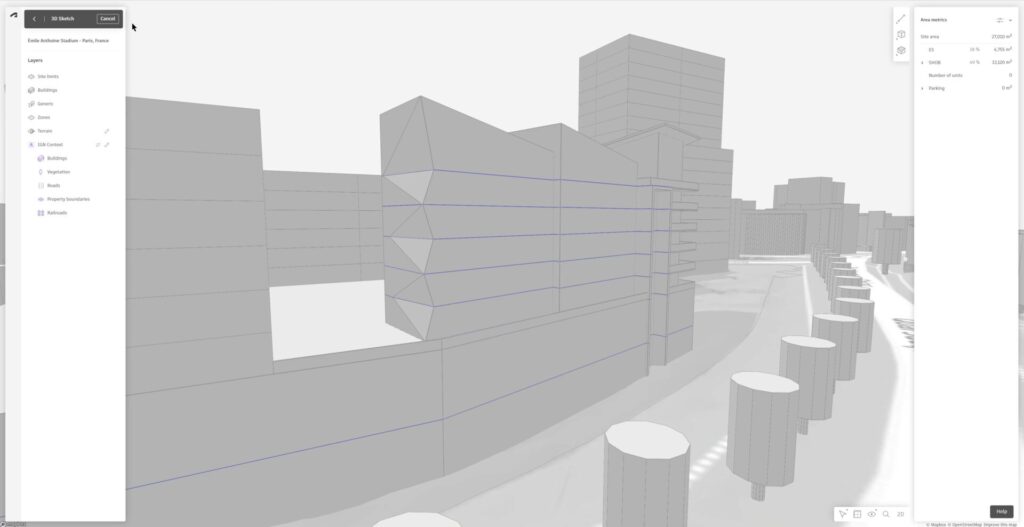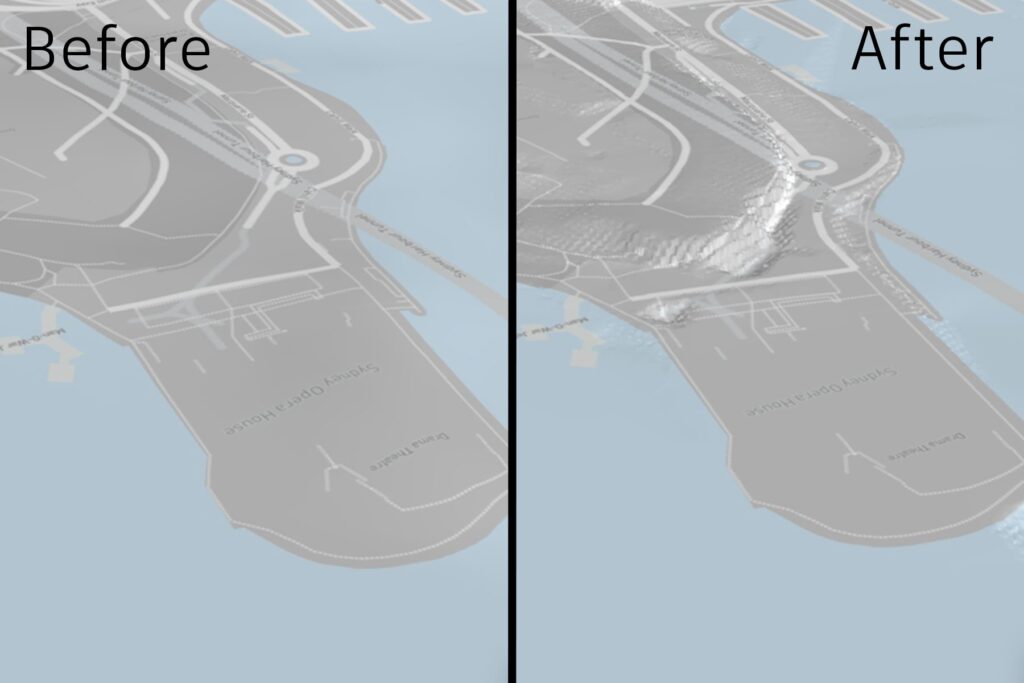Editor’s note: You can watch the on-demand version of our product update webinar here.
Hi there. It’s Jesper, from the Forma team.
I’m currently sitting down with a cup of coffee in Manchester, UK, after going through pages and pages of changes and updates to Autodesk Forma from changes.autodeskforma.com (login required) and I’ve had some time to reflect back on the last four and a half months since we launched Autodesk Forma. What a trip!
The soundtrack running through my head right now is Part of this world from The Little Mermaid by Disney:
Look at this stuff
Isn’t it neat?
Wouldn’t you think my collection’s complete?
We launched Autodesk Forma in May this year. The offering we launched in May was a mere tech demo just months before, but we had a clear target, much planning and preparation done, equipped with a boatload of experience, and a fantastic team to pull it off!
Launching was just a milestone. Autodesk Forma is a modern cloud solution, and with that comes a continuous flow of product updates, fixes, feedback and inventions. It’s a journey together, not a destination!
Since we launched, until end of September, the product team have shipped 72 significant updates to Forma. That’s an average of 3.7 updates per week!

We’ve everything from improvements to existing features, to new analyses, new features, to new ways of thinking about the AECO (Architecture, Engineering, Construction and Operations) platform that invites the whole ecosystem to contribute.
And in this post, I wanted to give you all the download on what updates have been released for Forma, why this excites me as an architect, and why it should excite you too. You can also watch me and Daria talk about all these updates and more by joining our on-demand webinar here!
The Solar Energy analysis beta

This analysis sheds light on, not only the solar panel potential of your project, but in general the amount of solar energy that hits your project, this can inform anything from future HVAC- and insulation needs to unveiling potential for solar capture in all its both emerging forms and the tried-and-true standards.
As an architect we’ve probably all had thoughts and conversations about how our project should leverage solar energy to contribute to the sustainability of our community, but sometimes thoughts are hard to translate to actionable insights at this early stage.
Forma changes this and gives you a starting point to discuss the viability of solutions in this space, from day one, as soon as you’ve started massing your site.
The analysis is in its infancy in Forma, having been launched only weeks ago, so we’re really keen on your first impressions and your feedback. Let us know what you like, what you dislike and where we can make immediate improvements! Read more here: https://blogs.autodesk.com/forma/2023/10/12/realize-the-potential-of-formas-solar-energy-analysis/
The Detailed Noise analysis beta

We also finally released the open beta for the Detailed Noise Analysis: The big sister of the Rapid Noise analysis we released at launch. With statistics, and CNOSSUS-EU simulations of traffic noise conditions in your project based on road speeds and traffic conditions.
A fan favorite for architects back in our Classic offering, it reemerges with improved support for all 3d geometries in your project. If you asked me back when I was at my architecture studio if I would like to run preliminary noise analysis myself before collaborating with our Noise and Traffic Consultants, I’d probably not see the point. I now know more about architecture and noisescapes than ever before, and I am a better architect for it!
Improvements to massing is so easy to do when you can visualize the results as you design and sets you up for the best possible collaboration downstream in your project. 10/10 – would recommend giving it a try.
I wrote more about this here: https://blogs.autodesk.com/forma/2023/09/18/detailed-noise-analysis-helps-architects-do-groundwork-for-noise-assessments/
Extensions in Forma

Autodesk is building an open ecosystem for AECO. And what better place to walk the walk after talking the talk than on Autodesk Forma?
Forma offers an environment for partners, third-party developers, techy architects and just about anyone with grit and goals to create extensions to Forma.
And the ecosystem gets priority here, we’re running product managers, subject matter experts, and internal developers from talk-to-talk nerding out about what it takes to get started with creating your own extensions on Forma.
The documentation is really extensive. The first few third-party extensions have made their way into the product already and there are so many more coming (that I’m not allowed to talk about yet. 🙊)
Extensions can be used for so much. Custom analyses, like localized versions of base analysis offered in Forma tailored to your market, or completely new explorations, or even new additional features!
The Rhino3D extensions

As proof of concept on how we imagine extensions we’ve built a fledgling extension that connects Rhinoceros 3D by our friends over at McNeel Group and associates, to Forma. The extension is built internally by a squad in Autodesk connecting to open APIs and allows you to model your project in Rhino, using contextual data sources through Forma, and streaming that geometry filelessly to Forma!
So, if your fingers write Rhino command prompts in their sleep and your architecture requires NURBS to realize your vision, go right ahead and combine that with the outcome-driven design that Forma enables with its contextual analysis and optimizations.
As is norm at Autodesk Forma: we release the beta as soon as it provides some value to our users and then we listen intensely to your feedback on where we go from here. It’s not a complete suite, it’s a start to a journey we want to take together.
Join the beta forums and let us know here!
The Revit extension

We also internally built an extension that lets you sync two-way between Forma and Revit. Start your project off right in Forma, with contextual data and initial massing studies supported by analysis, and then when the time is right, send it to Revit to convert your Forma project to BIM (Building Information Modeling) elements to start your documentation process.
Send your Revit model back to Forma to confirm your design as you design in Revit, should those balconies be 2m deep or does that take too much daylight from the apartments below? Before you’ve detailed your BIM to a level where Autodesk Insight can give you the whole download (what type of glass panes are you using? What’s your sill height? Do you want deep set or shallow windows frames?) you can keep track of progress by keeping an eye on the Daylight Potential of your Revit project in Autodesk Forma.
Since launch we’ve shipped four updates to the Revit extension addressing feedback, adding functions, increasing stability, and the journey continues. This extension is the brainchild of a team of developers that eat, breathe and live Revit, now building this connection between these two essential software!
Now let’s look at third-party extensions available on Autodesk Forma!
The TestFit parking generator

From the generator geniuses over at TestFit we got a parking generator extension for Forma, if you need on-group parking with tons of customization, like ADA parking spot compliance, then grab this extension today directly inside Forma.
The ShapeDiver extension

If you’ve got some solid Grasshopper scripts that you’d like to run on Forma, you can also use ShapeDiver to turn these scripts into tiny tools that can be executed in your project in Forma.
I can’t wait to see what other companies, independent developers and the techier architects amongst us will build on Forma in the future.
Our very own 3D Sketch tool has been on a continuous update spree since launch!

One of the biggest wins for our team at Forma is that we got access to the FormIt IP (Intellectual Property) and with that: a team of fantastic developers determined to bring advanced 3D editing tools directly in Forma!
With 12 updates since launch this team is on the leaderboard for most updates to Forma since launch. From minor fixes, to substantial load improvements the 3D Sketch tool in Forma is receiving a lot of love, and there is so much more to come.
For now, 3D Sketch lives in its own little sub-mode, a way to swiftly and effectively launch features to the tool without having to wait for anyone else. It’s like a very internal extension of our own. bit by bit these capabilities are now making their way into the core Design Mode, changing the ways we can interact with 3d in Forma.
My favorite workflow currently is to pop together buildings in Design Mode that roughly hits my density and quality metrics before enhancing and converting these geometries in 3D Sketch. Sloped roofs, overhangs, brise-soleils, railings, statues, you name it, 3D Sketch brings it, leveling my Forma projects up from ‘sugar cubes’ to sweet concepts.
This is getting wordy, I’m sorry, there is just so much that has happened in Forma since launch. Let’s flash through some of the remaining, uhm… 50+ updates!
New data providers!

Forma does not create or own any of the contextual data we offer in the product, instead we connect it to existing databases and let them offer their datasets directly in Forma. Some of these are free but may come with licensing restrictions, like no exports to Revit. But hey! Free is free right?
We are also now seeing more and more data providers offering their data to sell on Forma, and we welcome more of them. If the data provider you want to use isn’t connected to Forma today, let us know in the link in our data order field and let your provider know you’d like to purchase their data directly on Autodesk Forma. Help us help you.
The data you purchase is yours to do with as you please, dependent on the agreement you have with your provider of course.
Since launch we’ve connected to new data providers in
Canada – Australia – Sweden – Germany – Denmark – The US
And just to namedrop the rest of the updates we released since launch:
- Stats for detailed wind and microclimate analysis
- Buildings placed by the Explore feature are placed on terrain
- Added “Look from” tool.
- Added QuickAccess search for key actions in designmode.
- Rapid Noise out of beta: better error communication and stability
- Zone filtering of Area Metrics
- Saving camera positions available in Design mode
- P is hotkey for switching between 2D/3D perspectives
- Ability to toggle surroundings when editing an instance in 3D Sketch
- Improvement to reference image scaling
- Time interval filtering added to sun analysis
- Ability to edit analysis color settings
- Show 2D elements on terrain textures
- Stats for detailed noise analysis
- Terrain mode release
- Better height estimation for OpenStreetMap buildings
- Screen captures from design mode
- Reference image import and placement
- 4K Screen capture in design mode
- Upgrade Classic to Standard
- We have integrated with the new service of Dataforsyningen in Denmark
- New contextual edge tools for 3D Sketch
- It’s now possible to snap to non-editable building/volume edges and their mid-points in 3D Sketch
- Select Team when creating a Hub
- Recent projects are updated with projects you recently opened
- Other elements in app can open the toolbar to specific items
- Smooth proposal switching
- Introducing ‘Open/Closed Hub’, Invite-only project ‘On/Off-by-default’ and Hub Settings
- 3D Sketch navigation bar is updated to more closely resemble Terrain mode
- Basic buildings can now be added and used in Library
- The hub selection drop down now displays hubs for both regions
- Add terrain to library
- Layer toggling in 3D Sketch
- Added interpolation and filled transparent gaps for analysis textures in detailed noise analysis
- New Help menu experience
- Copy-paste emails address from Outlook directly into invite field
- See (disabled) properties of selected base elements
- Invite link visible and easier to add to clipboard
- Terrain fetching in Norway and the Netherlands is updated
- Tool improvements in 3D Sketch
- Make it easier to copy & paste email addresses for hub and project invites.
- Moved most actions moved into context menu opened on right click.
- Show roughness & wind rose source in wind analysis
- We have made some improvements to the usability of the Noise analysis
- Base elements always hover-able and selectable
- Admins can see and join invite-only projects
- Tweaks to our member roles
- Ground texture (map or satellite photo) is more crisp
- Site limits, zones, and constraints now display in 3D Sketch
If you’ve made it this far, thank you for reading! If you want to keep abreast on product updates as they are released, or want to read up on any of the above topics I didn’t have space to cover, keep an eye out of the in-product notifications and changes.autodeskforma.com for the freshest updates that are streaming your way.
PS: Me and my friend Daria did a webinar where we talked about all these updates and more next week. You can watch the recording of our Quarterly Product Updates Webinar for Forma here!
Hope to see you there! Until next time,
Jesper